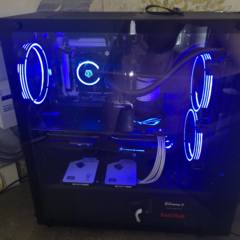-
Posts
477 -
Joined
-
Last visited
LucidMew's Achievements
-
I'm still waiting for the Define R4 unboxing/review.
-
Except that the GCN architecture is limited to 64CUs total. Both the Fury X and the Vega 64 are limited to 64CUs and, even the 290X had 64 ROPs (but 44 CUs). AMD would need to drastically redesign the architecture to surpass that limit, which, considering they're not going to do the RnD to cut off half-ish of the HBM, (which has its own host of problems), I doubt they would. #WaitForVegaNavi
-
One thing that I don't see mentioned very often, is that you can use your android device to load an ISO image on it, and then boot from it to install windows, for instance. https://www.maketecheasier.com/install-windows10-from-android/ (requires root)
-
What's wrong with VP9? I thought that was supposed to go up against HEVC/h.265 (and it won imo). What am I missing?
-
Think I got the timezones right. But not year subtraction right. He was born 31 32 years ago, today, on August 20, 1986. FeelsBirthdayMan
-
Linus: At what point in the future do you think you're going to "grow out" of the warehouse you're in now and buy another building to shoot in?
-
Yeah, it's been "out" for a while. Why has it all of a sudden been making the headlines lately? It's not new news.
-
"Lazy" is a term in computer programming that pretends to load the information and if that information is actually used then it actually calculates it for you. https://en.wikipedia.org/wiki/Lazy_evaluation You can have an "infinite" list in python, and store it with a finite amount of memory, because you only calculate what you actually use. It's also commonly used in databases as well with Hibernate.
-
Source 1: https://www.intel.com/content/www/us/en/security-center/advisory/intel-sa-00145.html Source 2: http://seclists.org/oss-sec/2018/q2/189 Honestly, I don't care about all these vulnerabilities. I'm not going out of my way to patch my 5820K, because I'm not a cloud service provider. However, with all these similar vulnerabilities being found with Intel's CPUs, I wonder how many unknown vulnerabilities are still undiscovered, and when all these will actually be fixed in hardware. There is a patch available on the seclists website, but I'm not sure what exactly that patches; Intel's website says software engineers can use Eager FP restore instead of Lazy FP state restore, so it seems like an update to windows and/or applications can fix this? It's not entirely clear if that'll fix it, or even if it's exploitable from javascript from the browser. These sort of registers do hold AES encryption keys, so it's fairly high priority for people who actually use it. edit/update 1: For those who don't know, "Lazy" is a term in computer programming that pretends to load the information and if that information is actually used then it actually calculates it for you. https://en.wikipedia.org/wiki/Lazy_evaluation You can have an "infinite" list in python, and store it with a finite amount of memory, because you only calculate what you actually use. It's also commonly used in databases as well with Hibernate. Another source that puts it in more human readable terms: https://www.theregister.co.uk/2018/06/13/intel_lazy_fpu_state_security_flaw/ No word if desktop windows 7/8.1/10 is patched or not. I guess it kinda makes sense that eager might be faster than lazy, depending on the data size and how frequently they need to be evaluated to its actual value. But I would think that it's more complex than "more often than not, eager is faster than lazy". Mitigated for years. Cool. People don't have to freak out. And AWS is protected. With no exploit code using this bug discovered in the wild just yet.
-
I give this a very generous three episodes before no more are made, and it's forgotten by everyone.
-
I'm quite a bit late to this thread, but I'm surprised that nobody brought up Dan Luu. https://danluu.com/perf-tracing/ has some good tips on how to get actually accurate CPU reporting times, while going through the process on debugging some really poor performing RPC's. (and also read up on https://en.wikipedia.org/wiki/Nyquist–Shannon_sampling_theorem (linked in that blogpost) as well.) On topic, this has been known about in the HPC sphere for a long time. https://danluu.com/intel-cat/ (about half way through is the juicy bits) You can "double up" on (some) workloads that are not competitive with each other (For example, if one task needs 100% of the DRAM bandwidth and 0% of the network bandwidth, and the other task needs the opposite, the two tasks would be able to co-locate on the same machine and achieve 200% effective utilization.) Companies can and do this sort of thing, and reap the huge benefits that that includes.
-

New BITMAIN ASIC Mines Equihash = 15x1080Ti GPUs at 300 Watts
LucidMew replied to Enkephalin's topic in Tech News
This is actually a pretty damn big deal. After reading the Equihash algorithm whitepaper, I've always liked the algorithm. Super customizable and requires a bunch of memory, plus the fact that GPUs get not even a thousand solutions a second is pretty cool. -
This OP: iPhone X is dead That OP: iPhone X got 35% of the industry profits in 2017 :thinking:




.thumb.jpg.154201dfcf508c84edffddfdaf56fb41.jpg)



.png)



